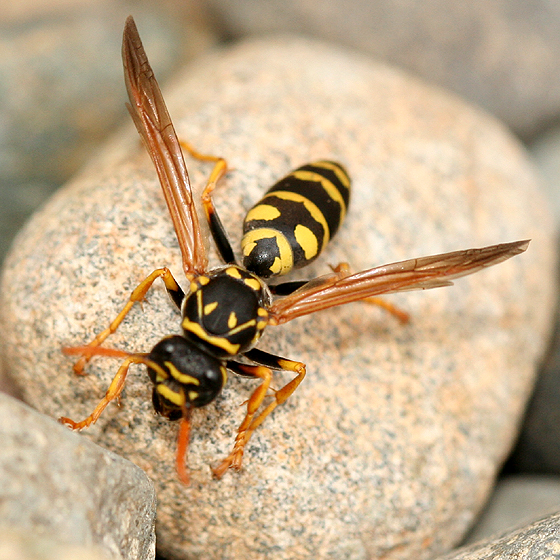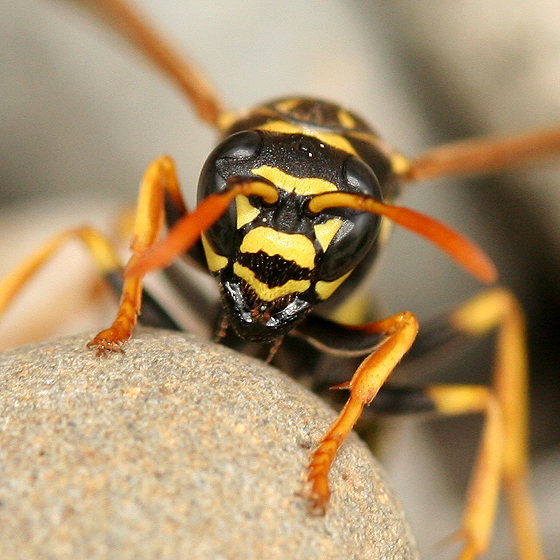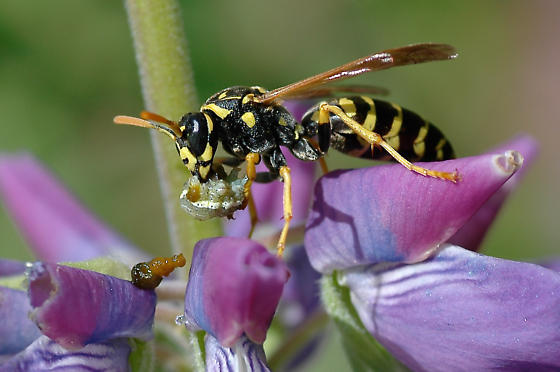Polistes dominula BIO 203
Form and Function
Polistes dominula also known, as the European paper wasp is an invasive species to North America and is often confused for yellow jackets. P. dominula wasps are black in color with yellow markings on the head, abdomen and clupeus (face) (Animal Diversity Web 2013). The yellow markings have to do with gender and dominance within the nest. The heads of the P. dominula wasps have a pair of orange antenna to sense and for mating. The bodies of P. dominula wasps are made of three tagmata, or sections, including the head, abdomen and thorax (Animal Diversity Web 2013). The body constricts between the thorax and abdomen. They also have a pair of wings and six legs (Colorado State University Extension 2013, Animal Diversity Web 2013).
Paper wasps use their wings to fly and
perform other tasks. Paper wasps characteristically fly with their hind
legs below their body (Animal Diversity Web 2013, Colorado State
University Extension, Penn State Extension 2011).
2011).
P. dominula wasps display sexual dimorphism with females being larger than males. Females usually are 2.0 cm in length compared to males that are only on average 0.79cm in length (Animal Diversity Web 2013). The size difference in males and females plays a critical role in the mating of paper wasps because females can choose who they want to copulate with. Copulation between male and female paper wasps happen when the male paper wasp wraps his antennae around the female's antennae and mounts her making genital contact. Females are able to deny males from copulating with them by flying away from them, by moving their abdomen so that the male cannot make genital contact and by actively removing them with stinging or biting. The female’s larger size allows them to do this and insures that they only mate with the males that are the most dominant (This process is also a way to show dominance amongst the hive. The interaction page has more information on dominace.)(Izzo and Tibbetts 2012).
In addition to the sexual dimorphism in size, male and female P. dominula wasps also differ in the location
of their markings that show dominance (Encyclopedia of Life 2011). Male
wasps show their marks for dominance with abdominal spots and the
smaller more elliptically shaped spots reflect a higher level of
dominance (Encyclopedia of Life
 2011, Izzo and Tibbetts 2012). In contrast
females show their
marks of dominance on a yellow area of the head called the clypeus.
Differences in the size, number and shape of the black dot on the yellow
clypeus convey dominance (Encyclopedia of Life 2011).
2011, Izzo and Tibbetts 2012). In contrast
females show their
marks of dominance on a yellow area of the head called the clypeus.
Differences in the size, number and shape of the black dot on the yellow
clypeus convey dominance (Encyclopedia of Life 2011).
P. dominula wasps are omnivorous and eat both plants and animals. Paper wasps often prey upon the insect larvae and caterpillars. (Animal Diversity Web 2013). Paper wasps kill their prey by attacking it and then stinging their prey with their stinger (UW-Milwaukee 2013). They then use their chewing mouthparts known as mandibles, a characteristic of the Hymenoptera order, to chew their food (Campbell et al. 2008). The prey chewed up by the wasp’s mandibles are then swallowed and regurgitated to feed the young larvae within the nest (UW-Milwaukee 2013, Animal Diversity Web 2013). Paper wasps also drink the aphids produced by honeydew and the nectar of flowers (Animal Diversity Web 2013, UW-Milwaukee 2013, Campbell et al. 2008). As P. dominula wasps search for food they often carry the pollen from the plants that they come into contact with, for this reason these wasps are able to pollenate a variety of different plants (Animal Diversity Web 2013).
Although P. dominula wasps prey on
a variety of insects many different animals also prey upon them. P.
dominula wasps use aposematic coloration to warn potential
predators of their powerful stinging capabilities (Vidal-Cordero et
al. 2012). Aposematic coloration is a technique used by a variety
of organisms in which they use bright coloration to warn would be
predators of their physical or chemical
defenses (Campbell et al. 2008). In the case of the P.
dominula wasp it uses its bright yellow and black coloration on its
abdomen to warn predators of its powerful sting (Vidal-Cordero
et
al. 2012).  Even with the warning of its aposematic coloration P.
dominula wasps still find themselves prey for foxes, raccoons, rodents
and songbirds (UW-Milwauke 2013, Liebert et al. 2006).
Even with the warning of its aposematic coloration P.
dominula wasps still find themselves prey for foxes, raccoons, rodents
and songbirds (UW-Milwauke 2013, Liebert et al. 2006).
P. dominula’s morphology also plays a part in being such a viscous attacker. When a P. dominula wasp stings; its victim gets a double hit. The stinger on a P. dominula wasp is extremely pointy and jabs into the victim. The stinger also injects venom into the victim that is stored within the abdomen of the wasp (UW-Milwaukee 2013). The European paper wasp does not have a barb on the end of its stinger so that after it stings its victim the stinger does not rip off. This allows the same wasp to sting repeatedly without dying (European Paper Wasp 2013). When P. dominula stings, it also releases a chemical signal to tell other wasps to attack (European paper wasp 2013). The venom injected by the wasps contain enzymes that break down cell membrane and substances that stop blood flow to the area of a sting to keep venom localized. In addition to theses substances, the venom contains chemicals that cause swelling and itching, and neurotransmitters that send messages of pain the to victims brain (UW-Milwaukee 2013). Studies have recently shown that the amount of toxin that a wasp contains is directly linked to the brightness of its aposematic coloration, with more brightly colored P. dominula wasps containing the most venom (UW-Milwaukee 2013, Vidal-Cordero et al. 2012).